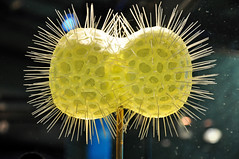Radiolarians are exquisitely beautiful amoeboid protozoa that have been living as zooplankton in the world’s oceans for about 600 million years.
These tiny, siliceous, single-celled organisms with their intricate mineral skeletons make-up the world's smallest clocks. Because they occur in continuous and well-dated sequences of rock over large portions of the ocean's bottom, these minuscule microfossils act like a yardstick, helping geologists accurately date rock from around the globe from the Cabrian onwards.
So, take off that Timex and strap-on your protozoa. Not as accurate to the hour but an interesting time piece nonetheless.



